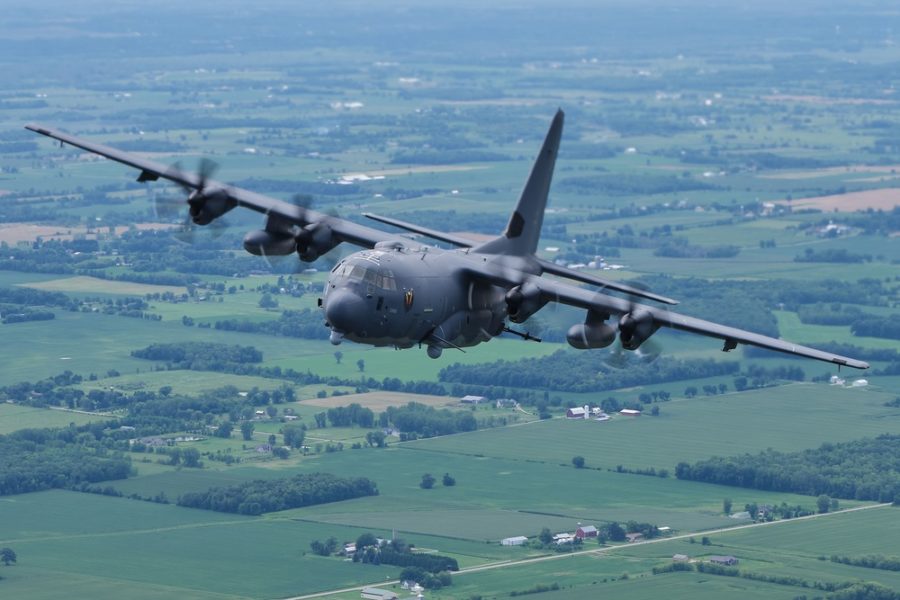The AC-130J is AFSOC’s primary CAS, air interdiction, and armed reconnaissance platform optimized for convoy escort, point defense, and supporting urban combat.
The next-generation gunship is designed to provide ground forces a persistent direct-fire platform and is based on a highly modified MC-130J. Airframes are retrofitted after delivery with the modular Precision Strike Package, wing-mounted weapons, and gunshipspecific systems.
 The initial aircraft was overstressed beyond repair when it departed controlled flight during a test sortie on April 21, 2015. Ghostrider deployed to combat for the first time in Afghanistan in June 2019.
The initial aircraft was overstressed beyond repair when it departed controlled flight during a test sortie on April 21, 2015. Ghostrider deployed to combat for the first time in Afghanistan in June 2019.
AC-130Js are upgraded and managed in common with the HC/MC-130J, and are receiving Block 8.1 avionics upgrades along with the baseline C-130J.
SOF-specific enhancements are rapidly developed and integrated in response to operational requirements. The aircraft’s PSP weapons system, initially developed on the AC-130W, includes a dual mission management console, robust communications suite, two EO/IR sensors, advanced fire-control equipment, PGM delivery capability, and trainable cannons.
Block 20 added a 105 mm gun, laser-guided SDB, side-facing pilot tactical HUD, and Large Aircraft Infrared Countermeasures (LAIRCM). Block 20+/30 improved gun accuracy, hardened GPS, and added Hellfire missile and Small Glide Munition as a result of lessons learned in operational testing.
The first Block 30 was delivered for testing in 2019 and retrofit of the last five aircraft is slated for FY24. AFSOC recently reduced its planned buy from 37 to 30 aircraft, receiving the final aircraft at Cannon Nov. 2, 2022. The command scrapped plans to demonstrate an Airborne High Energy Laser (AHEL) weapon that could have added low probability of detection strike capability against electronics, and light vehicle targets this year.
AFSOC is considering removing the 105 mm gun from equipped airframes to reduce aircrew as well as adding AESA radar to improve range, accuracy, and all-weather targeting. Ongoing upgrades include reengineering and modernizing of the 105 mm gun, radio frequency countermeasures (RFCM) to detect, locate, and respond to threats, defensive systems upgrades, and HF/VHF/UHF/ SATCOM suite modernization. AFSOC plans to shift AC-130J formal training from Hurlburt to Kirtland, though implementation has been delayed.
Contractors: Lockheed Martin, Sierra Nevada Corp (RFCM).
First Flight: Jan. 31, 2014.
Delivered: July 29, 2015-present.
IOC: Sept. 30, 2017.
Production: 31.
Inventory: 29.
Operator: AFSOC; Planned: AETC.
Aircraft Location: Hurlburt Field, Fla.; Cannon AFB, N.M. Planned: Kirtland AFB, N.M.
Active Variants: •AC-130J Ghostrider Block 20. Production standard gunship with additional 105 mm gun. •AC-130J Ghostrider Block 30. Production aircraft with post operational test upgrades.
Dimensions: Span 132.6 ft, length 97.7 ft, height 39.1 ft.
Weight: Max T-O 164,000 lb.
Power Plant: Four Rolls-Royce AE 2100D3 turboprops, each 4,700 shp.
Performance: Speed 416 mph, range 3,000 miles (farther with air refueling).
Ceiling: 28,000 ft.
Armament: Trainable 30 mm GAU-23/A cannon; 105 mm cannon; up to eight wing pylon-mounted GBU-39 SDB or AGM-114 Hellfire; aft-firing GBU69B Small Glide Munition or AGM-176 Griffin (deployed from 10 Common Launch Tubes integrated into the aircraft’s ramp/door).
Accommodation: Two pilots, CSO, WSO, sensor operator, loadmaster, and three gunners.


